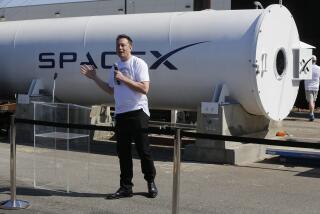Seeding the future with ‘podcars’
Today, everyone wants to get out of the foreign oil money pit. We talk about reducing the use of petroleum through conservation, building cars with better mileage or developing alternative fuels that will not pollute or at least produce less pollution.
That’s good, but the cost of oil and emissions are not the only problems with automobiles. We have congestion; accidents with injuries and deaths, and courts tied up with the resultant lawsuits; acres of land devoted to roads and parking; high costs to buy, insure and maintain a car; and lack of mobility for those who are unable or unwilling to drive.
In the near future, 70 million of us will enter retirement, and inevitably some of us will lose the ability to drive a car, whether from physical disability, poverty or denial of insurance. We will need something better than the auto -- and better is here, now.
It’s a “podcar,” also called “personal rapid transit” -- a system of vehicles that provide on-demand, private, nonstop travel. These vehicles can carry people or light freight. They ride on small, overhead guideways -- like a monorail or people mover -- above existing roads, and are powered entirely by electricity. Picture the car as an elevated, driverless taxi. It’s under computer control, so there would be no accidents, thereby saving lives and lowering insurance costs.
Podcars operate on demand, waiting at off-line stations; they can be summoned if one is not available when you arrive at the station. Each vehicle can hold four people, yet the system can be cost-effective even with a single rider for each trip.
The capital cost is low, about $25 million to $40 million a mile for the first systems, which include guideways, vehicles and stations, compared to $100 million to $300 million a mile for light-rail or subway systems. Because it operates over existing streets and sidewalks, there are few costs for rights of way or taking of private property. It is also inexpensive to operate and thus can be available 24/7 and still make an operating profit, depending on pricing policies.
Detractors say it can’t be done: That to be cost-effective, public transit must mass large groups of people together to travel to the same place; that a podcar system would be too complex and expensive; that an elevated guideway would be ugly.
The naysayers haven’t done their homework. A podcar system called ULTra is being built at London’s Heathrow airport. Vectus, a Korean podcar, is being tested in Uppsala, Sweden. One or both of these systems may be used in the Masdar eco-city in the United Arab Emirates that is being planned as the world’s first auto-free, carbon-free new town.
This indicates that those who are buying the systems believe they are cost-effective even in the more costly early stages of development. Visual intrusion is in the eye of the beholder, but the small scale of podcar guideways makes them unobtrusive over city streets and sidewalks. Existing wires and street lighting also could be run through the guideway, reducing visual clutter.
Although the ultimate goal would be a network connected to serve most of the urbanized population of an area such as Los Angeles, the first small podcar networks could enhance existing rail and bus systems by providing an easy and convenient way for passengers to get to their final destination when they leave the larger system. The existing rail system might be better patronized if passengers had a podcar system connecting Union Station with the rest of downtown. Another system could link the Green Line, hotels, airport parking and car rentals with LAX.
Such connections could be created rapidly as guideways are built in factories and then bolted onto pre-staged footings. A city block can be completed in a day and an entire network completed in a few weeks or months, not years, as with rails.
Private developers, shopping malls, universities and industrial complexes also could build internal networks and connect them to the public network.
Current public transit can only serve those who live near stations or bus lines and who want to travel where and when the system operates. That’s why most people prefer a car that’s available 24/7, if we can drive and can afford the gas.
There have been no significant service innovations in public transit in more than 100 years. Streetcar, subway and rail systems were introduced in the 19th century. Even the monorail, often seen as something new, was first used in Germany in 1901. Buses were introduced in London in 1905, and automobile use became widespread in the U.S. in the 1920s.
Podcars offer a new kind of service, providing the convenience of an auto without the negatives for the individual -- costly to purchase plus high costs for gasoline, insurance, maintenance and parking. For society, podcars would reduce the use of petroleum as well as pollution, congestion, accidents, injuries and deaths.
With governments in Europe and South Korea already supporting this development, the U.S. needs to get onboard and begin test runs on the podcar designs being created in this country.
Catherine G. Burke is an associate professor at USC’s School of Policy, Planning and Development.






